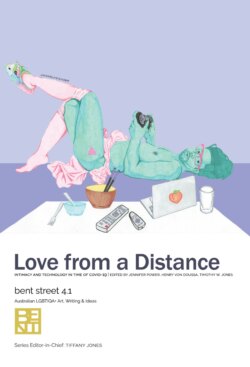Читать книгу Bent Street 4.1 - Tiffany Jones - Страница 18
How to Design a Queer Sex Bot
ОглавлениеPerhaps a queer sex bot would be a bot, or series of bots, that reflect more diverse representations of humanity. Bots with different body types? Different coloured skin? Different abilities? Different accents? Bots with cool hair? Bots wearing chaps? Or perhaps it would be bots with changeable forms. A bot with modular genitals? (See Figure 1). A bot whose gender appearance shifts across a spectrum of bodily capacities and gendered representations? A bot whose form ranges from human to non-human—goblin, daemon, angel, vampire slayer What would the image of a queer bot even be?
I can see marketing potential in the ultimate queer bot whose body can take any form. A body that presents in its own unique way, with infinite possibilities. The separation of the physical body from identity. The extraction of biology from gender. The ultimate queer body.
But of course, queer is not just about the physical form. Being queer is a stance in the world. It is about the ways we make sense of gender and sexuality. The way we resist, reshape or transgress cultural expectations.
Queerness in a bot would have to exist in its programming—or its deprogramming. Imagine a bot that has no idea about the rules of gender because it has not been programmed with gendered scripts or expectations. What if a bot is never taught to be passive in a feminised way, or has no idea what it means to ‘be a man’? Perhaps a queer bot is one that has no idea about heterosexual ‘rules’ of engagement. This lack of script might make for the ultimate queer bot.
However, a truly queer bot might also need programming to understand where it sits in the world. Queer consciousness is shaped by the experience of being queer in a world where cisgender, heterosexual and able bodies dominate most of the space. This is an experience of belonging and of not belonging, of understanding how to hack normative scripts. Of knowing both the liberation and oppression that comes with this. Of alienation and creative resistance. Of rejection and joy. Do we need to program an experience of marginalisation into our bot for it to be truly queer? Does the bot need to hold some fire of radical resistance to the everyday messages that queer is wrong or bad or deficient? What does this then mean for our bots? Are they just about sex? Or does our queer bot also, by definition, bring a measure of intimacy and emotional connection for a human based on recognition of some shared experience?
Even raising these questions begins to infer the possibility that for our queer bot to be possible it must hold a level of consciousness. This risks taking us deep into the tunnels of artificial intelligence, something I do not wish to do here. However, I do want to talk about agency (in a queer context). Ultimately, a bot is programmed by a human. Capacity for artificial learning aside, a bot has no capacity to make decisions outside of the limited range of options and behaviours written for it by its programmer. In this sense, it is an object of control. It can be manipulated to behave in the ways its human makers tell it to behave. Can a bot be queer if it has no consciousness and no capacity to independently understand its place in the world? Can it be queer if it cannot consciously choose to conform or resist cultural norms? Can it be queer if it has no capacity to seek pleasure on its own terms? Surely this lack of agency is the antithesis of queer experience and queer identity.
